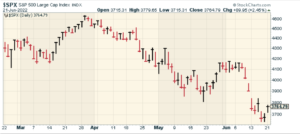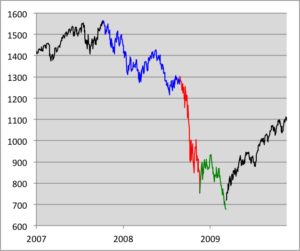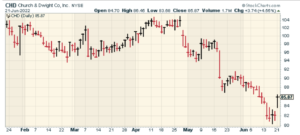CWS Market Review – June 21, 2022
(This is the free version of CWS Market Review. If you like what you see, then please sign up for the premium newsletter for $20 per month or $200 for the whole year. If you sign up today, you can see our two reports, “Your Handy Guide to Stock Orders” and “How Not to Get Screwed on Your Mortgage.”)
The Worst Market Since 1932
The good news is that the stock market rebounded on Friday and today. The bad news is that that comes after a very sharp selloff. Last week was the worst week for the S&P 500 in two years, and this is the worst start to a year for the S&P 500 since 1932.
I know it’s painful, but to borrow from Hyman Roth in The Godfather 2, “this is the business we’ve chosen.” This is what markets do. Every so often, the stock market goes through a stretch where it can’t seem to do anything right. Fortunately, these periods don’t last long.
For prudent long-term investors, bear markets are very good opportunities. When other investors panic and sell, that usually offers a great chance to pick up bargains. In a bit, I’ll tell you about one of my favorites that just got an upgrade. Wall Street is the only place where a sale is announced and everyone runs out of the store screaming.

One of the important truths of the stock market is that it tends to rise slowly and drop off quickly. The old saying on Wall Street is that bulls walk up the stairs while bears jump out the window. Boy, is that right.
Today’s surge was a good example of a contra-trend rally. That’s a fancy phrase meaning all that stuff that’s been doing horribly did well today, and all the stuff that’s been doing well did poorly today. Bitcoin did very well today, as did Tesla. I’m not sure how long that will last. As we know, bear market rallies are common and mainly false.
You could even call this a “double contra-trend rally” because the previous trend was the opposite of the previous rally.
Confused? I don’t blame you. In this week’s issue, I’ll try to make some sense of what’s going on.
How to Break Down the Bear
Not only are bear markets sharp and quick, but even within bear markets, the most painful days are bunched together. The market crash of 2008 is a good example. I need to explain that I follow a slightly different chronology from convention.
I think it’s better to see the market blowup of 2008-2009 in three segments. There was the “initial selloff” from October 9, 2007 to August 28, 2008. Then came the “panic phase” from August 29, 2008 to November 20, 2008. Finally, there was the “retest phase” from November 20, 2008 until March 9, 2009.
The initial selloff lasted 224 days and the S&P 500 lost 16.90% (blue line). The panic phase lasted 59 days and the market lost 42.15% (red line). Ouch! The retest phase was 72 days and the market lost 10.09% (green line).
(There’s nothing official about those phases. I just made them up, but I think it’s a better way to analyze what happened.)

My point is that the panic phase was by far the worst of the worst. By no means do I want to ignore the other two periods, but those were fairly standard lousy markets.
Which brings me to 2022. I suspect that we just came through our panic phase. In seven days, the S&P 500 lost 11.9%. That’s slightly more than half of the entire bear market (-23.6% through last Thursday).
In plainer terms, it took more than 100 days to make half of our losses. It took seven days to make the other half. The panic phases are sharp and unpleasant, but they tend to be short-lived. It looks like we may be past ours. The hard part is that we’ll only know for sure in retrospect.
Historically, the worst parts of a bear market don’t happen at the start. More often, the pattern is that of a slowly rolling snowball that turns into an avalanche. That happened in both 1987 and 1929. As the small losses mounted, the panic spread and those small losses became big losses.
The market panic of two years ago is an exception. Once the world understood the gravity of Covid, the market quickly tanked. In March 2020, the Dow Jones Industrial Average had two of its worst five days in market history. There’s a famous Variety cover from 1929, “Wall St. Lays an Egg.” The market drop of March 16, 2020 was worse than that.
The Fed Holds the Key
How much will the selling go on? That’s impossible to say. The Federal Reserve holds the key. Since 1950, the S&P 500 has had 17 drops of 15% or more. Of those drops, 11 times the market reached its low as the Fed started to lower interest rates.
For now, the market expects the Fed to hike rates by another 2% before the end of the year. As long as inflation is a threat, then pressure will be on the Fed to raise rates, and there’s no sign that inflation is abating. Companies are feeling the pressure. According to FactSet, 417 companies mentioned inflation during their Q1 earnings calls.
What really spooked the Fed was the recent report from the University of Michigan on consumer sentiment. It said that households expect inflation to run at 3.3% for the next five years.
This is major a concern because so much of inflation is self-fulfilling. When consumers expect inflation, they get it. Jerome Powell talks a lot about expectations for inflation. Once expectations take hold, they’re not so easy to change.
The unpleasant reality is that the Fed has a very poor track record of attacking inflation without causing a recession. To a limited degree, you can say that may have happened in the mid-90s. Outside that, the evidence is not in the Fed’s favor.
I don’t think an economic inflation is imminent, but the odds of one starting within the next 12 months are high. Goldman Sachs just said it placed the odds at 30%, but that’s an increase from where they had it at 15%. For a recession within two years, Goldman placed the odds at 48%. Historically, stocks have fallen 24% during recessions. We’ve nearly done that without a recession.
Church & Dwight Is an Ideal Defensive Stock
Recessions are Wall Street’s most honest auditor. That’s when you really see which companies are strong and which are not.
Recessions also reveal which companies are closely tied to the economic cycle. During a recession, you want to make sure you own plenty of defensive stocks. These are businesses whose fortunes don’t depend so much on where we are in the economic cycle.
Speaking of defensive stocks, we had good news today for one of the best defensive names on our Buy List. Shares of Church & Dwight (CHD) were upgraded by Wells Fargo. The firm raised CHD to a buy from neutral.
Like so many other stocks, CHD has struggled this year. At the start of the year, CHD was close to $105 per share. Lately, it’s been as low as $80 per share. Wells Fargo said that its stable of businesses is poised to withstand any setback in the economy.

Church & Dwight is about as defensive a stock as you can get. The company makes condoms and baking soda. When will that lose demand?
For Q1, Church & Dwight had earnings of 83 cents per share. That beat expectations of 77 cents per share.
For the year, C&D sees earnings growth at the low end of their 4% to 8% range. The company said that’s due to the pressures from inflation. For Q2, CHD expects sales growth of 5% to 6% and earnings of 70 cents per share. I think they can beat that.
While CHD has been selling a lower volume of products, thanks to price increases, revenue is up. Last quarter, net sales increased 4.7% to $1.28 billion.
Thanks to the upgrade, shares of Church & Dwight rallied 4.6% today. The next earnings report is due out late next month.
If you want to learn about the other names on our Buy List, then please sign up for a premium subscription: $20 per month or $200 for the whole year.
That’s all for now. I’ll have more for you in the next issue of CWS Market Review.
– Eddy
Posted by Eddy Elfenbein on June 21st, 2022 at 6:14 pm
The information in this blog post represents my own opinions and does not contain a recommendation for any particular security or investment. I or my affiliates may hold positions or other interests in securities mentioned in the Blog, please see my Disclaimer page for my full disclaimer.
-
-
Archives
- June 2025
- May 2025
- April 2025
- March 2025
- February 2025
- January 2025
- December 2024
- November 2024
- October 2024
- September 2024
- August 2024
- July 2024
- June 2024
- May 2024
- April 2024
- March 2024
- February 2024
- January 2024
- December 2023
- November 2023
- October 2023
- September 2023
- August 2023
- July 2023
- June 2023
- May 2023
- April 2023
- March 2023
- February 2023
- January 2023
- December 2022
- November 2022
- October 2022
- September 2022
- August 2022
- July 2022
- June 2022
- May 2022
- April 2022
- March 2022
- February 2022
- January 2022
- December 2021
- November 2021
- October 2021
- September 2021
- August 2021
- July 2021
- June 2021
- May 2021
- April 2021
- March 2021
- February 2021
- January 2021
- December 2020
- November 2020
- October 2020
- September 2020
- August 2020
- July 2020
- June 2020
- May 2020
- April 2020
- March 2020
- February 2020
- January 2020
- December 2019
- November 2019
- October 2019
- September 2019
- August 2019
- July 2019
- June 2019
- May 2019
- April 2019
- March 2019
- February 2019
- January 2019
- December 2018
- November 2018
- October 2018
- September 2018
- August 2018
- July 2018
- June 2018
- May 2018
- April 2018
- March 2018
- February 2018
- January 2018
- December 2017
- November 2017
- October 2017
- September 2017
- August 2017
- July 2017
- June 2017
- May 2017
- April 2017
- March 2017
- February 2017
- January 2017
- December 2016
- November 2016
- October 2016
- September 2016
- August 2016
- July 2016
- June 2016
- May 2016
- April 2016
- March 2016
- February 2016
- January 2016
- December 2015
- November 2015
- October 2015
- September 2015
- August 2015
- July 2015
- June 2015
- May 2015
- April 2015
- March 2015
- February 2015
- January 2015
- December 2014
- November 2014
- October 2014
- September 2014
- August 2014
- July 2014
- June 2014
- May 2014
- April 2014
- March 2014
- February 2014
- January 2014
- December 2013
- November 2013
- October 2013
- September 2013
- August 2013
- July 2013
- June 2013
- May 2013
- April 2013
- March 2013
- February 2013
- January 2013
- December 2012
- November 2012
- October 2012
- September 2012
- August 2012
- July 2012
- June 2012
- May 2012
- April 2012
- March 2012
- February 2012
- January 2012
- December 2011
- November 2011
- October 2011
- September 2011
- August 2011
- July 2011
- June 2011
- May 2011
- April 2011
- March 2011
- February 2011
- January 2011
- December 2010
- November 2010
- October 2010
- September 2010
- August 2010
- July 2010
- June 2010
- May 2010
- April 2010
- March 2010
- February 2010
- January 2010
- December 2009
- November 2009
- October 2009
- September 2009
- August 2009
- July 2009
- June 2009
- May 2009
- April 2009
- March 2009
- February 2009
- January 2009
- December 2008
- November 2008
- October 2008
- September 2008
- August 2008
- July 2008
- June 2008
- May 2008
- April 2008
- March 2008
- February 2008
- January 2008
- December 2007
- November 2007
- October 2007
- September 2007
- August 2007
- July 2007
- June 2007
- May 2007
- April 2007
- March 2007
- February 2007
- January 2007
- December 2006
- November 2006
- October 2006
- September 2006
- August 2006
- July 2006
- June 2006
- May 2006
- April 2006
- March 2006
- February 2006
- January 2006
- December 2005
- November 2005
- October 2005
- September 2005
- August 2005
- July 2005
 Eddy Elfenbein is a Washington, DC-based speaker, portfolio manager and editor of the blog Crossing Wall Street. His
Eddy Elfenbein is a Washington, DC-based speaker, portfolio manager and editor of the blog Crossing Wall Street. His